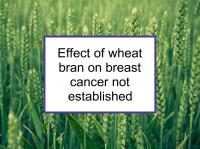Wheat bran is the hard outer layer of wheat (Triticum aestivum) grains. Along with wheat germ (the embryo), wheat bran is an integral part of the whole grain; both are removed during milling in the production of refined flour. Wheat bran is a very good dietary source of ferulic acid, insoluble fiber, niacin, selenium and vitamin B6.
In addition, wheat bran is a source of other B vitamins, including folate, riboflavin, thiamin and pantothenic acid, as well as enterolactone and some vitamin E. Wheat bran also incorporates the heavy metal cadmium, in addition to phytic acid, an anti-nutrient which limits the bioavailability of minerals such as cadmium, as well as iron, zinc and calcium that are found in wheat bran as well.
Wheat bran has been shown to have antioxidant properties. Cereal fiber (including bran) intake has been shown to be associated with lower risks of diabetes and cardiovascular disease. Consumption of wheat bran has also been found to be associated with lower risk of colon cancer. Note that a separate webpage covers the effects of eating bread on breast cancer risk.
Breast cancer-related effects of consuming wheat bran
High levels of whole grain consumption have been linked to reduced risk of breast cancer. However, we have not assigned a recommendation to wheat bran since there is not enough available data that is specific to wheat bran and breast cancer. However, wheat bran has an overall favorable profile and is safe to consume in moderation by those with breast cancer.
Below is a summary of a wheat bran-specific study, followed by information concerning important components of wheat bran.
Wheat bran-specific animal study
One study using a mouse model of breast cancer reported that the female offspring of mice fed a whole wheat-rich diet during pregnancy had a lower incidence of carcinogen-induced mammary tumors than controls.
Ferulic acid
Ferulic acid has been shown to induce programmed cell death in triple negative (ER-/PR-/HER2-) breast cancer cells. Ferulic acid has also been shown to synergistically enhance the treatment effects of doxorubicin, paclitaxel, epirubicin, radiotherapy and tamoxifen. In addition, ferulic acid has been demonstrated to reduce the heart damage caused by doxorubicin in an animal study of doxorubicin-induced cardiomyopathy.
Dietary fiber
Wheat bran is an excellent source of insoluble fiber and also contains some soluble fiber. Insoluble fiber does not dissolve in water; it adds bulk to the diet and speeds up the passage of food and waste. Soluble fiber dissolves in water and forms a gel, which slows digestion. High intake of dietary fiber is associated with reduced risk of breast cancer. Please see our fiber webpage.
Selenium
Selenium is an essential element with numerous roles in maintaining good health, but high levels are toxic (selenium intake over 400 micrograms (mcg) per day can lead to selenium poisoning). Both inadequate and very high levels of selenium are associated with heightened cancer risk. Adequate levels of selenium have been shown to protect against breast cancer development and somewhat higher dietary levels of selenium have been linked to improved survival, although not all studies are in agreement.
A 2022 Swedish study reported that selenium appears to be associated with reduced breast cancer risk only in women with a particular genetic makeup. This could explain the inconclusive results reported in epidemiological studies.
Selenium has been shown to increase the effectiveness of some breast cancer treatments, including doxorubicin, paclitaxel, cisplatin, trastuzumab and tamoxifen. Selenium supplements are not recommended.
Enterolactone
Consumption of wheat bran results in the production of the lignan phytoestrogens enterolactone and enterodiol by intestinal microflora. This production is influenced by the characteristics of other foods ingested at the same time. High levels of enterolactone in the blood have been found to be associated with decreased risk of breast cancer in most studies.
Enterolactone has been found to suppress proliferation, migration and invasion of triple negative breast cancer cells. One large U.S. study found that urinary enterolactone was inversely associated with C-reactive protein (CRP), a marker of inflammation. Another study reported that high circulating levels of enterolactone reduced the risk of breast cancer recurrence and death among postmenopausal women, especially those with estrogen receptor negative (ER-) breast cancer.
Enterolactone has also been found to increase the sensitivity of breast cancer cells to radiation, thereby potentially enhancing the treatment effects of radiotherapy.
However, note that wheat bran is a less abundant source of enterolactone than flaxseed or whole rye.
Triticuside A
Triticuside A, a flavonoid found in wheat bran, has been reported to induce apoptosis and inhibit proliferation of breast cancer cells while having little cytotoxicity in normal breast cells, according to one study.
Additional comments
Other foods derived from the wheat plant, such as wheat germ, wheat germ oil, wheat grass and wheat sprouts are thought to have a variety of beneficial health effects, but few formal studies exist that examine the associations between these foods and breast cancer risk.
Wheat germ extract has been shown to inhibit experimental colon carcinogenesis in rats. Avemar, a fermented wheat germ extract, has been shown to inhibit the growth of human breast cancer cells transplanted into mice. Wheat germ oil is a good source of vitamin E.
Leaving aside its water content, wheat grass juice is approximately 70% chlorophyll. Wheat grass is also a good source of protein and contains numerous enzymes, vitamins and minerals. Wheat sprouts have been shown to have relatively high antioxidant activity.
Below are links to recent studies concerning this food and its components. For a more complete list of studies, please click on wheat bran.
